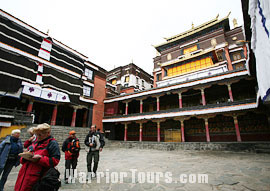Tashilhunpo Monastery & Shalu Monastery

![]() Tashilhunpo Monastery
Tashilhunpo Monastery
Tashilhunpo Monastery, meaning the Heap of Glory, is located at the foot of Drolmari (Tara's Mountain), Shigatse. It was originally founded by the First Dalai Lama in 1447, and expanded by the Fourth and successive Panchen Lamas. Covering an area of nearly 300,000 square meters (about 74.1 acres), Tashilhunpo is one of the 'Six Big Monasteries of Gelugpa'. Since the Fourth Panchen Lama took charge in the monastery, it has been the seat of Panchen Lama for hundreds of years.

A wall in front of the monastery was also built in the charge of the First Dalai Lama in 1468. It displays the thangka of Buddha on the 14th, 15th and 16th of May under Tibetan Lunar Calendar. Vivid images of Buddha are a must-see for visitors. What's more, the Maitreya Chapel inside amazes visitors by the biggest statue of a sitting Maitreya Buddha enshrined. It is 26.2 meters (86 ft) high and embellished with gold, copper, pearl, amber and many other gems. Visitors gets a good view of the Buddha on the upper floors.
The stupa-tombs of the Fourth, Tenth Panchen Lama and other abbots of Tashilhunpo are situated in the chapels. The Panchen Palace, which is the residence of Panchen Lamas has not open to public yet. The Chanting Yard was the place where Panchen Lamas once did sermons while nowadays lamas debate here every afternoon. The walls around are found thousands of images of Buddha with different poses. Rare sutras, thangkas, and other culture relics are well preserved in Tashilhunpo Monastery.
| Admission Fee: | CNY 55 |
| Opening Hours: | 09:00 to 17:00(closed for lunch from 12:00 to 14:00) |
| Recommended Time for a Visit: | Three hours |
![]() Shalu Monastery
Shalu Monastery
Lying 20 kilometers (12 miles) south of Shigatse, Shalu Monastery was founded in 1040 by Chetsun Sherab Jungnay. Shalu, meaning New Bud in Tibetan, was named after a story. His teacher suggested him to built a monastery where his arrow hit. The flying arrow finally hit a new bud. In 1320, Buton Rinpoche, one of the greatest religious scholars was invited to be abbot of the monastery. Buton's religious knowledge covered so wide a range that he brought together the one hundred and eight volumes of the fundamental texts of Buddhism, Kanjur, and the two hundred volumes of 'treaties and commentaries', Tenjur, and attracted over 3,000 monks to attend his sermon. Shulupa, or Butonpa took form under his leadership. However since he had no interest in politics, his sect was not very influential.

In Shalu Monastery, you encounter the most incredible view. Monks learned to raise their body temperature to a level that they can resist coldness wearing least clothes. In that process they run at a high speed to cover a long distance without rest.
In 1329, the monastery was demolished in an earthquake and in 1333, Buton rebuilt it under the patron the Chinese Mongolian emperor. Since many Han artisans participated the reconstruction the monastery combined Tibetan features and Chinese style of the Yuan Dynasty (1271-1368). The only one of this type exists in Tibet.
Shalu Lakhang is the center of the monastery. On the ground floor of the Tshomchen, Sakyamuni and his disciples are enshrined. The chapels flanking it houses Tanjur and Kanjur respectively. Chapels on the roof floor are typical Chinese blue tiled structures, housing Sakyamuni, Buton, and Arhats. Old but delicate murals cover the walls of the monastery, most depicting stories of Buddha. However restoration and preservation are badly needed.
Shalu Monastery holds four treasures. A sutra board being 700 years old and is said that it cannot be reassembled once broken apart. A piece of sutra printed against the board regarded a good luck. A brass urn, which is usually covered with a piece of red cloth and sealed, the holy water in it can clean hundreds of different filths which changed every 12 years. A stone basin, which was Chetsun Sherab Jungnay's washbasin. A stone tablet was uncovered in the first construction of Shalu, on which a mantra, om mani Padme Hum and four dagobas are carved.
| Admission Fee: | CNY 40 |


